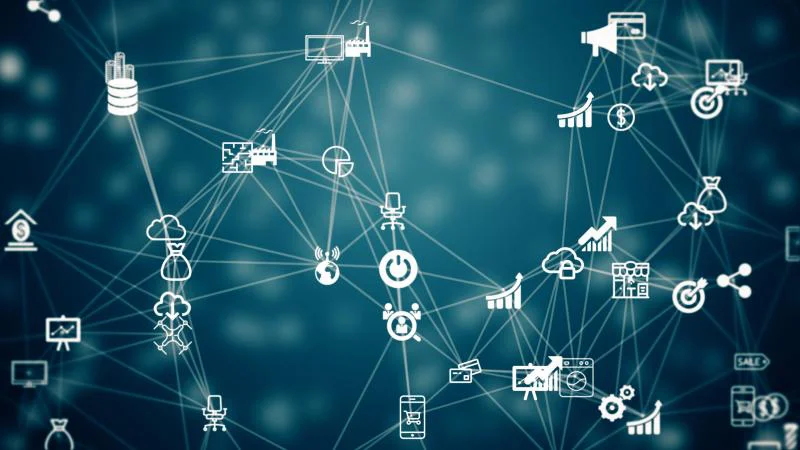The Internet of Things (IoT) and the Internet of Everything (IoE) are related concepts with distinct scopes and applications. IoT refers to the network of physical devices, vehicles, and structures embedded with sensors, software, and network connectivity, allowing them to collect and exchange data. IoT aims to create a more efficient and interconnected world by automating various processes and enhancing data-driven decision-making.
IoE is a broader concept that includes physical devices, people, data, and processes. It is the integration of the Internet of Things, humans, and intelligent systems to create a cohesive and interconnected environment. IoE seeks to enhance human experiences, encourage better decision-making, and enhance the overall quality of life.
The primary difference between IoT and IoE is their respective scopes and objectives. IoE broadens the scope beyond machine-to-machine communication, data capture, and automation to include human interactions, data analysis, and decision-making processes. IoT is the foundation for the broader and more inclusive Internet of Everything (IoE) concept, which seeks to create a smarter, more connected world that benefits machines and humans.
What is the Internet of Things?
The Internet of Things (IoT) is a network of physical items, like appliances, cars, and buildings, connected through sensors, software, and the Internet. This connection lets these devices collect, share, and analyse data on their own, which makes them more efficient and helps them make better decisions. IoT devices can be as simple as smart thermostats and wearables or as complicated as factory equipment and systems that track the supply chain. IoT devices provide useful information about the performance and efficiency of systems by collecting data in real-time. This lets systems be better controlled and optimised.
IoT is made possible by the fact that it’s getting cheaper and easier to connect to the Internet and by improvements in sensor technology and data processing. Because of this, IoT has been used in many fields, such as health care, agriculture, transportation, smart cities, and energy management. One of the main benefits of IoT is that it can automate tasks and processes, which can lessen the need for human help and make things run more smoothly. IoT systems can also improve safety and security by looking for possible risks and warning users about them. But IoT also has problems regarding data privacy, security, and how things work together. Taking care of these worries is essential for the responsible and long-term growth of IoT, which has the potential to change how we live, work, and connect with our environment in significant ways.
What is the Internet of Everything?
The Internet of Everything (IoE) is a big idea that goes beyond the Internet of Things (IoT) by connecting people, data, processes, and objects into a single, interconnected network. IoE wants to make a seamless, smart world that improves people’s lives, helps them make better decisions, and improves life in general. IoE is a bigger concept than IoT because it includes human-to-human and human-to-machine interactions. IoT focuses on connecting physical objects and machine-to-machine communication. This whole-systems method allows the combining of data from different sources, leading to better decisions and more efficient processes.
IoE can be used in many areas, such as healthcare, education, transportation, smart towns, and business. IoE can provide personalised experiences, use resources best, and drive creativity by connecting people, processes, data, and devices. IoE’s main benefits are increased efficiency, better collaboration, and the ability to make choices based on data. By connecting all the parts of a system, IoE can make it easier to automate and improve different processes, saving a lot of money and reducing waste. But putting IoE into place comes with challenges, such as ensuring data is private, safe, and can be shared with other systems. Taking care of these worries is essential for the responsible development and use of IoE technologies, which could change how we live, work, and connect with our surroundings.
Difference Between the Internet of Things and the Internet of Everything
The primary difference between IoT and IoE is in their respective aims and coverage areas. The Internet of Things (IoT) is an emerging technology that seeks to automate and collect data through machine-to-machine interactions and physical device connections. In contrast, the Internet of Everything (IoE) includes networked devices and humans, information, and organisational procedures. Connecting all parts of a system, including human interactions and data analysis, IoE attempts to improve human experiences, decision-making, and quality of life in general, while IoT focuses on improving efficiency and decision-making through automation. We’ve compared the terms “Internet of Things” and “Internet of Everything” and listed their key differences below.
Scope
The Internet of Things is predicated on the interoperability and connectivity between actual physical objects. In contrast, the Internet of Everything (IoE) includes a broader range, integrating devices, people, data, and processes.
Human Involvement
While the Internet of Things (IoT) is primarily concerned with automation, data collection, and device interaction, the Internet of Everything (IoE) is focused on enhancing human experiences through interactions between humans and machines.
Decision-making
Internet of Everything takes advantage of the insights from devices, people, and processes to encourage better, more informed decision-making than the Internet of Things data analysis and automation.
Objectives
The Internet of Things (IoT) aims to maximise productivity while decreasing overhead expenses. Internet of Everything (IoE) seeks to create a seamless, interconnected environment to improve quality of life, ease cooperation, and drive innovation.
Application Areas
Smart homes, factory automation, and public transit are just some of the most common places where the Internet of Things is used. The Internet of Everything (IoE) brings these benefits to areas where human interaction is essential, such as the classroom, the hospital, and the workplace.
Data Integration
Data collection is at the heart of the Internet of Things but in the Internet of Everything, data from devices, people, and processes are all brought together to form a complete picture of the system.







